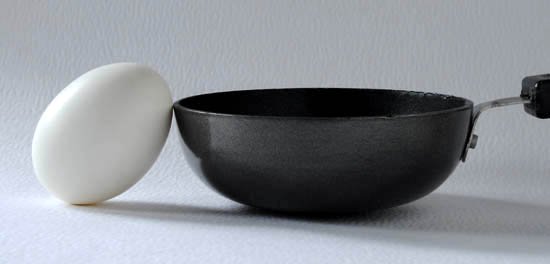|
Size in photography - an important elementSize in photography is a comparison of size of different objects. In a photograph, some objects easily give information about their size, as our brain recognize it with its previous memory. If we take a photograph of a pen, we know that it is about 5 1/2" or 6". However, some objects need help of other objects to compare the size.

The example above shows a utensil, but we cannot visualize or judge its size.

When a known figure is added, we can easily make out how small it is. Texture plays important role to give fair idea of size. However, it has a negative impact also. In commercial photography, a product like a medicine tablet will show all the small defects, when the photograph is enlarged. This is because of the texture.
That is why we use a dummy of a tablet for photography. It is the exact replica of actual product but of much larger size. Larger sized replica can be polished easily for smallest of defects. When this replica is shot without any other object to compare the size, our brain will assume it as a normal sized tablet. Size in photography as an element has very little role in food photography, especially when we are shooting a raw food. However, it has a prime consideration, when we shoot a prepared dish. The portion showed in a photograph cannot tell any thing about the actual quantity and it is misleading, if there is nothing to compare it with a known figure. This kind of manipulation is used in some restaurants, when they put photograph of a dish on menu card or on a display poster. Upon enlargement, the dish may look enough in quantity but the guest is disappointed when he looks at the actual serve. We must take care to avoid such disappointment. In architectural and industrial photography, element of size works with perspective and line to complete the picturesque appeal in a photograph. It can assist in producing three dimensional effect, when we shoot same sized objects in a row. The object close to the camera looks biggest and other objects looks smaller. Reduction in visual size depends on the distance. This is how, the illusion of depth is formed. Size and comparison has its own role to render depth in a photograph. In a photograph of a landscape, it is further assisted by perspective and tonal value to give depth in the image. When it comes to an engineering product, one cannot visualize the size of a product, as a nut can be one inch in diameter or six inch. If the use of a photograph is for artistic approach, then we can use a pencil or a human hand to compare and visualize the size of a nut. If the photograph is just for record purpose, then we can place a measuring ruler near the product. This technique of placing a measuring ruler is a must, when a photograph is of crime location and for forensic investigation. Though size in photography has less appeal as an element, it has its own importance.
Return back to Elements of image
Learn more about:
|






